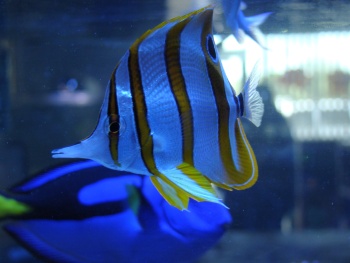
By Bob Goemans

Likely Reef Tank Suitable
Likely Fish-Only Tank Suitable
Range: Indo-West Pacific Ocean: Northwestern Australia/Great Barrier Reef north to Papua New Guinea, northwest to the Andaman Sea and Ryukyu Islands.
Size: 8 inches (20 cm)
Natural Environment: Inhabits rocky coastal reefs, in-shore reefs, lagoons, silty inner reefs and estuaries and is often found in turbid sheltered areas. Generally occurs at depths of 3 – 80 feet (1 – 25 m) and mainly feeds on worms, clams, tunicates, and crustaceans. Adults occur singly or in pairs, while juveniles are solitary.
General Husbandry: A highly attractive species, having a silvery-white body with wide orange yellow vertical black edged bands, a long narrow snout used to search crevices for food, and a black false eyespot on the rear upper body and lower dorsal fin. This is one of the more distinctive species of butterflyfishes and difficult to confuse with others in its family. Often a great addition to most reef aquariums when its needs are met.
Usually adapts quite easily in larger reef style aquariums or peaceful fish-only community aquariums. A meaty diet of live fortified brine shrimp, black worms (Lumbriculus variegatus), red worms (genus Tubifex) and/or mysis are usually eagerly accepted and should be offered several times daily.
Even though it can be maintained in reef aquariums with most soft and stony corals, its not fully trustworthy as its been known to nip at Xenia, zoanthids, Star Polyps and ocassionaly clam mantles. It’s also often purchased because it will decimate Aiptasia anemones, yet that does not always prove to be correct, especially if more suitable/preferred foods are available. It will also consume small decorative tubeworms and other useful small worms.
Sometimes difficult to get feeding in an aquarium, therefore, supplying it live foods such as feeder shrimp and bloodworms can aid in helping a Copperband Butterfly get used to life in the aquarium. Also, small human consumption clams/black mussels purchased in local grocery stores and placed on the half-shell in the aquarium will entice them to begin feeding. Over time, frozen foods like mysis and brine shrimp will be more readily accepted.
Taxonomy:
Order: Perciformes
Suborder: Percoidei
Family: Chaetodontidae
Genus: Chelmon
FYI: Preferably maintained without others in the same genus, except as a male-female pair, as the Copperband can become quite territorial and battle others for territorial rights.
Pressing some soft foods into openings/crevices on a piece of old dead coral skeleton can sometimes encourage finicky eaters to begin feeding.
Experience Level: Intermediate
Temperament: Peaceful
Diet: Carnivore
Coral Safe: Caution advised
Invertebrate Safe: Caution advised
Acclimation Time: 30 minutes+
Aquarium Environment: Reef aquarium (see above) and fish-only aquarium.
Tankmates: Peaceful or non-aggressive
Minimum Tank Size: 100 gallons
Temperature Range: 74 - 82°F (24 – 27°C).
Specific Gravity: 1.020-1.026
pH: 8.0 - 8.5
